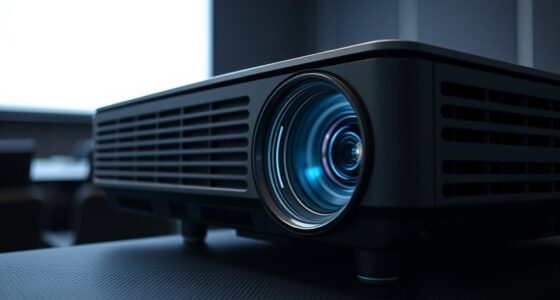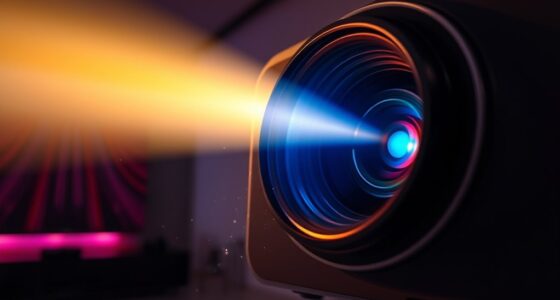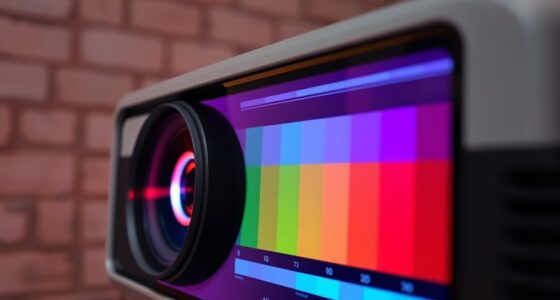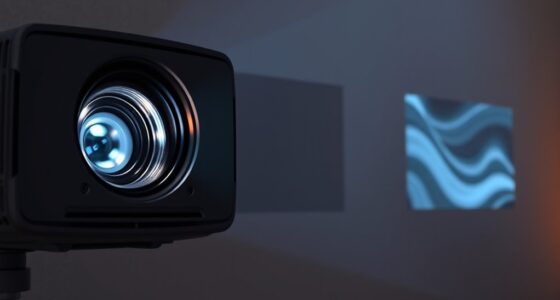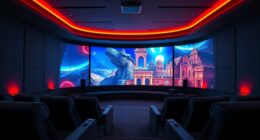The No-Nonsense Guide to Gamma and EOTF Basics Planning helps you understand how gamma controls the relationship between your video signal and displayed brightness, ensuring consistent and vibrant images. It explains how EOTF shapes how signals turn into visible light, especially important for HDR workflows. By grasping these concepts, you’ll learn how to calibrate your displays accurately, select the right settings, and maintain quality—setting a solid foundation if you want to master the full guide.
Key Takeaways
- Understand the difference between gamma (image curve) and EOTF (display luminance response) for accurate calibration.
- Follow industry standards like Rec. 709, PQ, and BT.1886 to ensure consistent video quality.
- Regularly calibrate and test displays using proper tools and test patterns to maintain accuracy.
- Adjust gamma based on content type, viewing environment, and workflow goals for optimal results.
- Maintain calibration routines and control ambient lighting to ensure ongoing image fidelity and consistency.
What Is Gamma and Why Does It Matter?

Have you ever wondered why some images look brighter or darker on different screens? That’s where gamma comes in. Gamma controls the relationship between a video signal and its displayed brightness, affecting how your image appears. It’s a key part of display calibration because it guarantees consistent brightness and contrast across devices. When performing color grading, understanding gamma helps you achieve the intended look and mood. Without proper gamma settings, an image might look washed out or overly dark, no matter how perfect your color palette. Recognizing the importance of gamma allows you to fine-tune your display for accurate image rendering. Additionally, AI-driven display calibration is increasingly used to optimize gamma settings automatically, ensuring consistent visual quality across various devices. Ultimately, mastering gamma makes your visuals more vivid, true-to-life, and consistent across screens.
Understanding EOTF and Its Role in Video Playback

EOTF, or Electro-Optical Transfer Function, determines how digital video signals are converted into visible images on your screen. It directly impacts image quality by controlling contrast and brightness, ensuring accurate reproduction of content. Understanding EOTF helps you appreciate how your display produces the vibrant and detailed visuals you see. Additionally, display technology plays a crucial role in how effectively EOTF is implemented to enhance viewing experiences.
EOTF Functionality Overview
Ever wondered how your device accurately displays bright highlights and deep shadows in video content? That’s the EOTF—Electro-Optical Transfer Function—at work. It transforms digital signal values into visible luminance, guaranteeing scenes look natural and consistent. During color grading and HDR workflows, this process is vital for maintaining the intended artistic and technical intent. EOTF shapes how light is reproduced, preserving details in both dark and bright areas. Understanding video signal processing is essential to grasp how these adjustments are made seamlessly. Here’s a quick glance at its core:
| Signal Level | Brightness Response | Visual Impact |
|---|---|---|
| Low | Preserves shadow detail | Deep shadows remain visible |
| Mid | Maintains natural look | Balanced midtones |
| High | Highlights brilliance | Bright highlights stand out |
Mastering EOTF ensures your content looks stunning, no matter the display.
Impact on Image Quality
Understanding how EOTF influences image quality is key to appreciating its role in video playback. When you get it right, it ensures accurate color grading and vibrant HDR visuals. EOTF determines how brightness levels are mapped from digital signals to display luminance, affecting contrast and detail in shadows and highlights. Proper EOTF application enhances the overall sharpness and realism of the image, especially during HDR implementation, where luminance range is expanded. If EOTF isn’t correctly calibrated, images can appear washed out or overly contrasty, diminishing visual fidelity. By mastering EOTF, you guarantee that colors are rendered precisely, and the intended artistic intent is preserved, resulting in a richer, more immersive viewing experience. Understanding the performance tuning behind display calibration is also essential for achieving optimal image quality. Ultimately, EOTF plays a critical role in delivering high-quality, visually compelling content.
Key Differences Between Gamma and EOTF

While gamma and EOTF are closely related concepts in display technology, they serve different purposes and operate in distinct ways. Gamma refers to the mathematical curve used during color grading and hardware calibration to adjust image brightness and contrast. In contrast, EOTF (Electro-Optical Transfer Function) describes how a display converts electrical signals into visible light, affecting how images are perceived in real-time. To clarify these differences: 1. Gamma is a mathematical curve set during content creation, mainly for consistent color grading. 2. EOTF is a device-specific function that defines how signals translate into light output. 3. Gamma is often standardized, while EOTF varies across display types. 4. Understanding both helps guarantee accurate image reproduction for consistent viewing experiences. Additionally, knowing the contrast ratio capabilities of a projector can significantly influence the perceived quality of the displayed image.
How Gamma Curves Impact Image Quality and Consistency

Gamma curves play a crucial role in shaping the overall image quality and ensuring visual consistency across different displays. They influence how brightness levels and contrast appear, directly affecting the effectiveness of color grading. A well-chosen gamma curve preserves detail in shadows and highlights, making images look more natural and appealing. When gamma is set correctly, viewer perception remains consistent, so your audience sees the intended visuals regardless of the device. Conversely, improper gamma settings can cause images to look flat, overly dark, or washed out, degrading perceived quality. By understanding how gamma impacts brightness and contrast, you can optimize your content for clarity, vibrant colors, and uniformity. Proper gamma calibration is essential for maintaining image fidelity and delivering a polished, professional image that maintains its quality across various viewing environments.
Common Standards and Settings for Gamma and EOTF

Are there standard gamma and EOTF settings that you should utilize to guarantee consistent image quality? Yes. Using industry standards helps ensure your display calibration and color grading efforts produce predictable results. Here are the key standards:
- Rec. 709: Common for HD TV, with a gamma of 2.4 and EOTF suitable for SDR content.
- PQ (Perceptual Quantizer): Designed for HDR, with an EOTF that matches human perception.
- SDR Gamma 2.2: Widely used for computer monitors and streaming, offers good consistency.
- BT.1886: A legacy standard for TV calibration, closely aligned with gamma 2.4.
- Display calibration practices often rely on these standards to establish reliable reference points.
Applying these standards simplifies color grading and display calibration, ensuring your visuals look consistent across different devices and viewing environments.
Practical Steps for Calibrating Your Display

To achieve accurate and consistent display calibration, start by adjusting your monitor’s brightness and contrast settings to recommended levels. This creates a solid foundation for precise color grading and ensures your display aligns with HDR standards. Use calibration tools or test patterns to fine-tune the gamma and EOTF, ensuring the grayscale and color accuracy meet industry benchmarks. Pay close attention to the display’s response in shadow and highlight areas, as proper calibration affects how details appear in dark and bright scenes. Recheck settings periodically, especially if you switch displays or lighting conditions change. Proper calibration helps you deliver consistent visuals, whether for professional color grading or enjoying HDR content at home. Accurate calibration is essential for achieving true-to-life images across all workflows. Incorporating color accuracy techniques can further enhance the precision of your calibration process.
Choosing the Right Gamma and EOTF Settings for Your Workflow

Choosing the right gamma and EOTF settings guarantees your display accurately reproduces the intended image quality for your specific workflow. This is essential for tasks like color grading and HDR implementation, where precision impacts final output. Consider these factors:
Selecting appropriate gamma and EOTF settings ensures precise, high-quality image reproduction tailored to your workflow needs.
- Your target medium—SDR or HDR—to select the appropriate EOTF curve.
- The type of content—film, video, or digital animation—to match gamma settings for optimal contrast.
- The viewing environment—bright or dim—to choose settings that maintain detail and color accuracy.
- Your workflow goals—creative grading, delivery standards—to fine-tune gamma and EOTF for consistent results.
- Understanding content relevance and authority helps tailor gamma and EOTF choices to ensure your visuals meet industry standards and audience expectations.
Tips for Maintaining Accurate Video Presentation

Maintaining accurate video presentation requires vigilant calibration and consistent monitoring throughout your workflow. Regular hardware calibration ensures your display stays true to its color and luminance standards, which is essential for precise color grading. Invest in quality calibration tools and perform routine checks to prevent drift that can distort your footage. Keep your environment consistent by controlling ambient light, as fluctuating lighting affects your perception of contrast and color. Use test patterns to verify your display’s accuracy regularly. Document your calibration settings to quickly identify issues. Consistent review of your workflow helps catch inconsistencies early, saving time and ensuring your final output remains true to your creative intent. Additionally, understanding your popular juice brands can inspire refreshment breaks that keep you energized during long editing sessions. These practices keep your video presentation as accurate and reliable as possible.
Frequently Asked Questions
How Do I Choose the Best Gamma Setting for Different Content Types?
To select the best gamma setting for different content types, start by considering your target display’s profile and the desired color grading look. For darker scenes, use a gamma that preserves shadow details, like 2.2 or 2.4. For bright content, opt for a gamma that maintains highlights. Always perform display profiling to guarantee consistent results, and adjust based on your workflow and viewing environment.
What Tools Are Best for Measuring and Adjusting Gamma and EOTF?
You need dependable tools like colorimeters and spectroradiometers to measure and adjust gamma and EOTF accurately. Some skeptics think these are too expensive, but investing in quality devices guarantees precise calibration, saving time and boosting image quality. Colorimeters are great for quick adjustments, while spectroradiometers provide detailed spectral data. Together, they give you thorough control, ensuring your displays meet the desired gamma and EOTF standards effectively.
How Often Should I Calibrate My Display for Optimal Gamma Performance?
You should calibrate your display at least once every three to six months to maintain ideal gamma performance. Regular calibration ensures consistent color and brightness, preventing drift over time. Follow maintenance tips like keeping your screen clean and avoiding drastic temperature changes, which can affect calibration. If you notice color shifts or image quality issues, increase calibration frequency. Staying proactive helps your display deliver the best visual experience consistently.
Can Incorrect Gamma Settings Cause Color Inaccuracies?
Incorrect gamma settings can indeed cause color inaccuracies, turning vibrant scenes into dull images or overly saturated colors into muddy hues. Think of it like a misaligned camera lens—your display’s color calibration gets thrown off, affecting every shade. Proper display calibration ensures accurate gamma, which directly impacts color accuracy. So, regularly checking and adjusting your gamma settings helps keep your colors true and vibrant, giving you a more consistent viewing experience.
How Do Ambient Lighting Conditions Affect Gamma and EOTF Calibration?
Ambient lighting conditions considerably impact your gamma and EOTF calibration. Bright ambient light can wash out contrast and cause glare, making your display appear dimmer and less accurate. To maintain proper calibration, you should manage glare with appropriate lighting or shades and calibrate in a controlled environment. This ensures your display’s gamma and EOTF are consistent, providing accurate colors and ideal picture quality regardless of ambient light fluctuations.
Conclusion
Think of gamma and EOTF like the engine and brakes of a car—they work together to keep your video smooth and true to life. When you calibrate them properly, it’s like hitting the perfect gear shift, making every scene pop with clarity. Just as a well-tuned vehicle runs effortlessly, your display will deliver consistent, stunning images. Master these basics, and you’ll guarantee your visuals always look their best—no matter the journey ahead.


